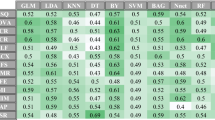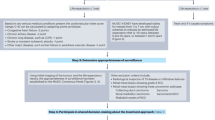Key Points
-
The indeterminate renal mass is a diverse clinical entity which includes both benign and malignant tumour types
-
Accurate knowledge of tumour histology is required for a risk-adapted approach to patient care; for example, benign or indolent renal tumours can be observed and more aggressive tumours treated surgically
-
Anatomical imaging techniques, including CT, MRI and ultrasonography, are unable to reliably distinguish between the various types of renal tumours
-
Renal mass biopsy is infrequently performed owing to a high nondiagnostic rate and risk of complications; a number of nuclear imaging tests have been explored as an alternative
-
One of the most promising of these tests is 124I-girentuximab PET/CT, which was shown in a large prospective study to accurately distinguish clear cell renal cell carcinoma from other tumour histologies
-
Additional work is needed to better define the relative strengths and limitations of the various nuclear imaging tests before they can be fully incorporated into clinical practice
Abstract
Patients presenting with a clinically localized renal mass should ideally be managed with a risk-adapted approach that incorporates data regarding the metastatic potential of a given tumour. Unfortunately, currently available anatomical imaging techniques are unable to reliably distinguish between the various types of renal tumours, which include both benign and malignant histologies. Nuclear imaging offers a potential noninvasive means to characterize clinically localized renal tumours. A number of nuclear imaging tests are currently under investigation for this purpose and might one day be incorporated into patient care.
This is a preview of subscription content, access via your institution
Access options
Subscribe to this journal
Receive 12 print issues and online access
$209.00 per year
only $17.42 per issue
Buy this article
- Purchase on Springer Link
- Instant access to full article PDF
Prices may be subject to local taxes which are calculated during checkout




Similar content being viewed by others
References
Siegel, R., Ma, J., Zou, Z. & Jemal, A. Cancer statistics, 2014. CA Cancer J. Clin. 64, 9–29 (2014).
Jemal, A. et al. Global cancer statistics. CA Cancer J. Clin. 61, 69–90 (2011).
Ljungberg, B. et al. The epidemiology of renal cell carcinoma. Eur. Urol. 60, 615–621 (2011).
Chow, W. H., Devesa, S. S., Warren, J. L. & Fraumeni, J. F. Rising incidence of renal cell cancer in the United States. JAMA 281, 1628–1631 (1999).
King, S. C., Pollack, L. A., Li, J., King, J. B. & Master, V. A. Continued increase in incidence of renal cell carcinoma, especially in young patients and high grade disease: United States 2001 to 2010. J. Urol. 191, 1665–1670 (2014).
De, P. et al. Trends in incidence, mortality, and survival for kidney cancer in Canada, 1986–2007. Cancer Causes Control 25, 1271–1281 (2014).
Frank, I. et al. Solid renal tumors: an analysis of pathological features related to tumor size. J. Urol. 170, 2217–2220 (2003).
Srigley, J. R. et al. The International Society of Urological Pathology (ISUP) Vancouver Classification of Renal Neoplasia. Am. J. Surg. Pathol. 37, 1469–1489 (2013).
Halverson, S. J. et al. Accuracy of determining small renal mass management with risk stratified biopsies: confirmation by final pathology. J. Urol. 189, 441–446 (2013).
Campbell, S. C. et al. Guideline for management of the clinical T1 renal mass. J. Urol. 182, 1271–1279 (2009).
Ljungberg, B. et al. EAU guidelines on renal cell carcinoma: the 2010 update. Eur. Urol. 58, 398–406 (2010).
NCCN Clinical Practice Guidelines in Oncology, Kidney Cancer version 3.2015 [online], (2015).
Rosenkrantz, A. B. et al. MRI features of renal oncocytoma and chromophobe renal cell carcinoma. AJR Am. J. Roentgenol. 195, W421–W427 (2010).
Kang, S. K., Huang, W. C., Pandharipande, P. V. & Chandarana, H. Solid renal masses: what the numbers tell us. AJR Am. J. Roentgenol. 202, 1196–1206 (2014).
Sevcenco, S. et al. Utility and limitations of 3Tesla diffusion-weighted magnetic resonance imaging for differentiation of renal tumors. Eur. J. Radiol. 83, 909–913 (2014).
Volpe, A. et al. Rationale for percutaneous biopsy and histologic characterisation of renal tumours. Eur. Urol. 62, 491–504 (2012).
Caoili, E. M. & Davenport, M. S. Role of percutaneous needle biopsy for renal masses. Semin. Intervent. Radiol. 31, 20–26 (2014).
Ball, M. W. et al. Grade heterogeneity in small renal masses: potential implications for renal mass biopsy. J. Urol. 193, 36–40 (2015).
Leppert, J. T. et al. Utilization of renal mass biopsy in patients with renal cell carcinoma. Urology 83, 774–779 (2014).
Johnson, D. C. et al. preoperatively misclassified, surgically removed benign renal masses: a systematic review of surgical series and United States population level burden estimate. J. Urol. 193, 30–35 (2015).
Rahmim, A. & Zaidi, H. PET versus SPECT: strengths, limitations and challenges. Nucl. Med. Commun. 29, 193–207 (2008).
Farwell, M. D., Pryma, D. A. & Mankoff, D. A. PET/CT imaging in cancer: current applications and future directions. Cancer 120, 3433–3445 (2014).
Bensinger, S. J. & Christofk, H. R. New aspects of the Warburg effect in cancer cell biology. Semin. Cell Dev. Biol. 23, 352–361 (2012).
Wang, H. Y. et al. Meta-analysis of the diagnostic performance of [18F]FDG-PET and PET/CT in renal cell carcinoma. Cancer Imaging 12, 464–474 (2012).
Ozülker, T., Ozülker, F., Ozbek, E. & Ozpaçaci, T. A prospective diagnostic accuracy study of F18 fluorodeoxyglucose-positron emission tomography/computed tomography in the evaluation of indeterminate renal masses. Nucl. Med. Commun. 32, 265–272 (2011).
Ho, C. L. et al. Dual-tracer PET/CT in renal angiomyolipoma and subtypes of renal cell carcinoma. Clin. Nucl. Med. 37, 1075–1082 (2012).
Oyama, N. et al. Diagnosis of complex renal cystic masses and solid renal lesions using PET imaging: comparison of 11C-acetate and 18F-FDG PET imaging. Clin. Nucl. Med. 39, e208–e214 (2014).
Lawrentschuk, N., Davis, I. D., Bolton, D. M. & Scott, A. M. Functional imaging of renal cell carcinoma. Nat. Rev. Urol. 7, 258–266 (2010).
Eisenhauer, E. A. et al. New response evaluation criteria in solid tumours: revised RECIST guideline (version 1.1). Eur. J. Cancer 45, 228–247 (2009).
Oyama, N. et al. 11C-Acetate PET imaging for renal cell carcinoma. Eur. J. Nucl. Med. Mol. Imaging 36, 422–427 (2009).
The Cancer Genome Atlas Research Network. Comprehensive molecular characterization of clear cell renal cell carcinoma. Nature 499, 43–49 (2013).
Bui, M. H. T. et al. Carbonic anhydrase IX is an independent predictor of survival in advanced renal clear cell carcinoma: implications for prognosis and therapy. Clin. Cancer Res. 9, 802–811 (2003).
Giménez-Bachs, J. M. et al. Carbonic anhydrase IX as a specific biomarker for clear cell renal cell carcinoma: comparative study of Western blot and immunohistochemistry and implications for diagnosis. Scand. J. Urol. Nephrol. 46, 358–364 (2012).
McDonald, P. C., Winum, J. Y., Supuran, C. T. & Dedhar, S. Recent developments in targeting carbonic anhydrase IX for cancer therapeutics. Oncotarget 3, 84–97 (2012).
Divgi, C. R. et al. Preoperative characterisation of clear-cell renal carcinoma using iodine124labelled antibody chimeric G250 (124I-cG250) and PET in patients with renal masses: a phase I trial. Lancet. Oncol. 8, 304–310 (2007).
Divgi, C. R. et al. Positron emission tomography/computed tomography identification of clear cell renal cell carcinoma: results from the REDECT trial. J. Clin. Oncol. 31, 187–194 (2013).
Gobbo, S. et al. Clear cell papillary renal cell carcinoma: a distinct histopathologic and molecular genetic entity. Am. J. Surg. Pathol. 32, 1239–1245 (2008).
Kuroda, N. et al. Clear cell papillary renal cell carcinoma: a review. Int. J. Clin. Exp. Pathol. 7, 7312–7318 (2014).
Meeting Materials, Oncologic Drugs Advisory Committee [online], (2012).
US National Library of Medicine. ClinicalTrials.gov[online], (2014).
Wilex Focussed Cancer Therapies. Company Update January 2015 [online], (2015).
Oosting, S. F. et al. 89Zr-bevacizumab PET visualizes heterogeneous tracer accumulation in tumor lesions of renal cell carcinoma patients and differential effects of anti-angiogenic treatment. J. Nucl. Med. 56, 63–69 (2015).
Cho, S. Y. et al. Biodistribution, tumor detection, and radiation dosimetry of 18F-DCFBC, a lowmolecularweight inhibitor of prostate-specific membrane antigen, in patients with metastatic prostate cancer. J. Nucl. Med. 53, 1883–1891 (2012).
Baccala, A., Sercia, L., Li, J., Heston, W. & Zhou, M. Expression of prostate-specific membrane antigen in tumor-associated neovasculature of renal neoplasms. Urology 70, 385–390 (2007).
Demirci, E. et al. (68)Ga-PSMA PET/CT imaging of metastatic clear cell renal cell carcinoma. Eur. J. Nucl. Med. Mol. Imaging 41, 1461–1462 (2014).
Schuster, D. M. et al. Initial experience with the radiotracer anti1amino3[18F]Fluorocyclobutane1carboxylic acid (anti[18F]FACBC) with PET in renal carcinoma. Mol. Imaging Biol. 11, 434–438 (2009).
Middendorp, M., Maute, L., Sauter, B., Vogl, T. J. & Grünwald, F. Initial experience with 18F-fluoroethylcholine PET/CT in staging and monitoring therapy response of advanced renal cell carcinoma. Ann. Nucl. Med. 24, 441–446 (2010).
Lawrentschuk, N. et al. Assessing regional hypoxia in human renal tumours using 18F-fluoromisonidazole positron emission tomography. BJU Int. 96, 540–546 (2005).
Beller, G. A. & Watson, D. D. Physiological basis of myocardial perfusion imaging with the technetium 99m agents. Semin. Nucl. Med. 21, 173–181 (1991).
Carvalho, P. A. et al. Subcellular distribution and analysis of technetium99mMIBI in isolated perfused rat hearts. J. Nucl. Med. 33, 1516–1522 (1992).
Gormley, T. S., Van Every, M. J. & Moreno, A. J. Renal oncocytoma: preoperative diagnosis using technetium 99m sestamibi imaging. Urology 48, 33–39 (1996).
Rowe, S. P. et al. Initial experience using 99mTc-MIBI SPECT/CT for the differentiation of oncocytoma from renal cell carcinoma. Clin. Nucl. Med. 40, 309–313 (2015).
US National Library of Medicine. ClinicalTrials.gov[online], (2015).
Author information
Authors and Affiliations
Contributions
M.A.G. researched data for the article. M.A.G. and S.P.R. wrote the manuscript. All authors made substantial contributions to discussions of content and reviewed and edited the article before submission.
Corresponding author
Ethics declarations
Competing interests
The authors have filed a provisional application for a patent regarding the use of 99mTc-sestamibi for the imaging of renal tumours.
Rights and permissions
About this article
Cite this article
Gorin, M., Rowe, S. & Allaf, M. Nuclear imaging of renal tumours: a step towards improved risk stratification. Nat Rev Urol 12, 445–450 (2015). https://doi.org/10.1038/nrurol.2015.122
Published:
Issue Date:
DOI: https://doi.org/10.1038/nrurol.2015.122



